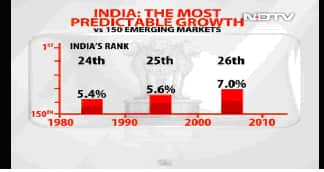There are great expectations that Narendra Modi, if he becomes Prime Minister after 16 May, will be able to revive economic growth quickly by bold reforms and other actions. Actually, if growth revives, it may not be anything to do with Modi, though his arrival on the scene will surely lead to economic optimism.
The reason why I am saying this is simple: individuals, however reformist they may be, do not have that big an impact on short-term economic growth. Also, big reforms happen only when the country faces a crisis. And when a crisis happens, any finance minister tends to be reformist.
Ruchir Sharma, emerging markets investment manager at Morgan Stanley, says that India has historically gone through an economic crisis every 10 years. In 1980, the country had to go to the IMF for a loan; in 1991, it again had to go to the IMF after we faced external bankruptcy; in 2001, after the global dotcom bust and the post-Pokharan economic sanctions, India again hit a growth slowdown and the NDA was forced to reform; and this time, after 2011, despite a high economic stimulus, we ended up with an external current account crisis, high inflation and slowdown.
During the last 30 years, we have had several Congress governments, a BJP government, and a United Front government - but the 10-year crises have been a regular feature. And every time we had a crisis, we have begun reforms. Even in 2012, reforms were resumed only after the UPA landed the economy in a crisis. This is attributed to the return of P Chidambaram to the finance ministry, but the fact is any finance minister would also have done reforms.
Ruchir Sharma also tells us that no matter what the government, India’s economic performance has been very steady over the last 30 years. Even though the Congress claims that the high growth of the last decade was the result of its government, Sharma’s statistics show that among 150 emerging market economies, India’s growth rank has always been somewhere between 24-26, from 1980 and now (see chart below).
[caption id=“attachment_81960” align=“aligncenter” width=“324”]  Chart 1[/caption]
In terms of inflation, India has been at Rank No 60 out of 150 (see chart below).
[caption id=“attachment_81961” align=“aligncenter” width=“341”]  Chart 2[/caption]
India’s economic performance has always been about 1 percent to 1.5 percent above the emerging markets average, which tells us that we rise and fall with the emerging markets. UPA-1’s high growth was not made in India. Even Africa grew very fast at that time.
However, Sharma said in an NDTV discussion last year that the recent economic slowdown in India had little to do with external factors and more to do with the mistakes made by UPA in 2009-12.
Sometime after 2008, when the world went into a financial crisis, India’s growth rank suddenly improved (see chart below**)**
[caption id=“attachment_81962” align=“aligncenter” width=“297”]  Chart 3[/caption]
to No 13 (from the usual 24-26). How did this miracle happen? Simple. The UPA government artificially pumped money into the economy through huge subsidies that it could not afford. This pushed up the growth temporarily.
This is like running on drugs and steroids. It can’t go on forever. Once the effects of artificial boosters wore off, the country’s growth crashed. Sharma’s calculation show that after 2011, India’s rank among emerging economies suddenly fell to 40, and its inflation performance fell from the usual 60 to 148 - that is India was the third from bottom among 150 emerging market economies.
So what does this prove? The UPA’s high growth years in 2004-08 were the natural result of global factors. The slowdown would have been less harsh if we had not artificially boosted growth in 2009-12. We would still have been ranking No 25 in terms of emerging markets growth. We would be growing at 6 percent instead of below 5 percent.
The moral of the story is simple: growth cannot be bought by artificial boosters. There is a natural rhythm for the Indian economy and all governments must respect that. Small doses of steady reform are good enough to maintain economic performance. Modi does not have to do anything spectacular to improve economic performance.
Source for charts: Ruchir Sharma, NDTV image grabs


)
)
)
)
)
)
)
)
)



